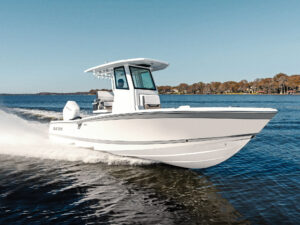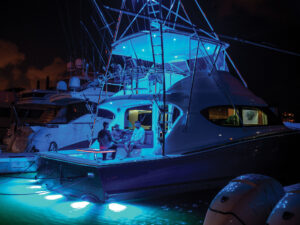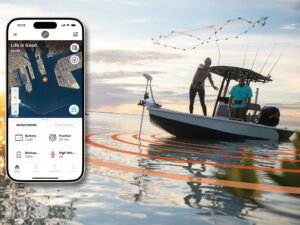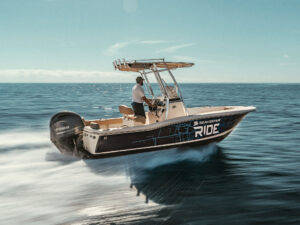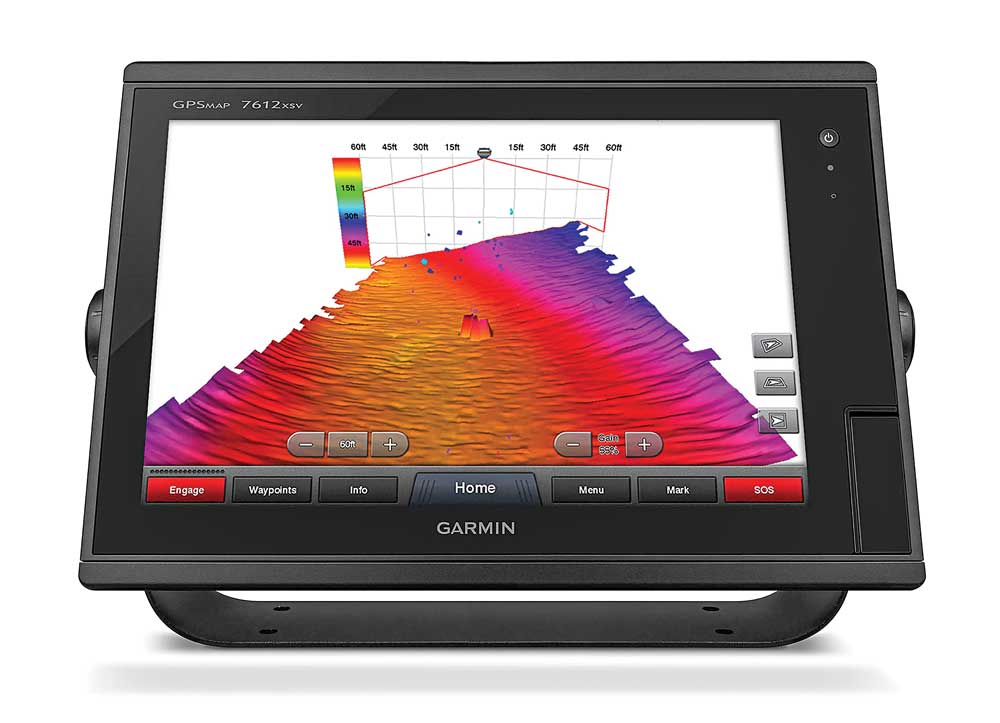
For years David Dunn has been fishing for grouper off North Carolina’s southern coast, but a new three-dimensional sonar system has given him fresh insight into the fish-holding structure in the waters he thought he knew well.
Dunn, director of sales and marketing for Garmin Marine, started using the Panoptix RealVu 3D Historical display option with the Garmin PS-30 transducer while trolling. “With 3-D sonar, we started finding little differences in the bottom structure, like ledges and crevices that aren’t on the charts, places we never knew about before,” he says.
The small ledges and crevices, where grouper live and feed, give Dunn a number of great new spots to target these fish. And this is just one example of how 3-D sonar benefits anglers. Today, five marine electronics brands — Furuno, Garmin, Lowrance, Raymarine and Simrad — offer 3-D sonar systems.
While the technologies vary, all use specialized transducers to scan the bottom and water column, and then represent that information on-screen in a three-dimensional format.
Scanning Technology
Sister brands Lowrance and Simrad offer the StructureScan 3D system, which requires an add-on module with a separate transducer. It works with the Lowrance HDS Gen3 and HDS Carbon, as well as with Simrad NSS/NSO evo2 and NSS evo3 multifunction displays.
The system offers a choice of two high frequencies — 455 and 800 kHz — to create three-dimensional images of fish, seabed and structure with abundant detail, particularly in shallow waters. You can also change the perspective to look at the 3-D imagery from various angles, helping to identify fish-holding nuances in wrecks, ledges and reefs. It scans a side-to-side swath to a maximum range of 600 feet to each side and 300 feet down in StructureScan 3D mode.
Raymarine’s new Axiom series MFDs are available with built-in three-dimensional sonar imaging called RealVision 3D. One transducer (in low-profile through-hull and transom-mount versions) combines chirp DownVision, SideVision, high frequency and RealVision 3D in a single housing.
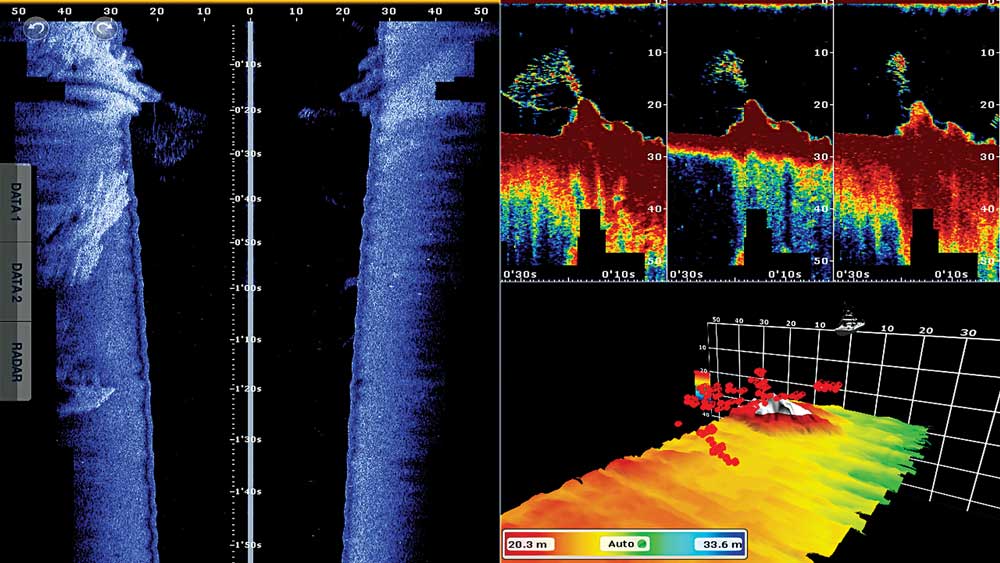
Stabilized Image
The Raymarine Axiom transducer features a solid-state AHRS (attitude and heading reference system) gyroscopic stabilizer to eliminate lumpy bottom readings in rough seas. Any irregularity in the bottom is truly structure, says Jim McGowan, marketing manager for Raymarine.
“AHRS stabilization also prevents the 3-D image from getting turned or warped when the boat’s heading shifts back and forth slightly,” McGowan explains. “As a result, RealVision 3D offers an accurate depiction of structure. “The biggest advantage of 3-D sonar is gaining perspective of where fish are relative to the boat and structure,” McGowan says. These sonar systems are also helpful when looking for schools of baitfish. “They let you cover a lot of ground,” he adds.
RealVision 3D scans 180 degrees side to side at 350 kHz, which offers a balance between range and detail. “The built-in chirp sonar also enhances the detail that might be lost when going to a slightly lower frequency,” McGowan says. Maximum range extends to 300 feet down and to each side.
Phased-Array Systems
Both Furuno and Garmin use phased-array transducers to generate 3-D sonar images. Furuno’s new DFF-3D sonar system employs an eight-element transducer (in through-hull and transom-mount models) and an add-on black box processing module compatible with Furuno’s TZtouch and TZtouch2 MFDs. The three-dimensional sonar mode (one of four available modes) is called 3D Sounder History.
The transducer contains a nine-axis stabilizer that senses and compensates for pitch, roll, yaw and heave. “This keeps the beam from shooting all over the place in rough seas,” says Eric Kunz, senior product manager for Furuno USA. The DFF-3D scans 120 degrees side to side. The bottom reading remains flat, except when an object such as a wreck appears, Kunz says.
To maximize deepwater capabilities, the DFF-3D operates on a relatively low frequency — 165 kHz — which allows for reading depths to 1,000 feet and more than 650 feet to each side. To define the shape of structure, DFF-3D creates 41 individual channels, each with a 3-degree beam.
While some systems operate optimally at relatively low boat speeds of 2 to 8 mph, the Furuno system reads well at cruising speeds, Kunz says. “This lets you scan the bottom and look for bait schools and fish in 3-D mode without slowing down.”
Live Action
Garmin’s Panoptix system offers the distinction of real-time 3-D viewing, along with other display choices. With the Garmin PS-30 Panoptix phased-array transducer (or the PS-60 through-hull), you can choose RealVu 3D Down for a three-dimensional view that’s continually updated. The system is compatible with all current Garmin MFDs.
“I have found that the RealVu 3D Down view is particularly helpful for finding fish when the boat is sitting still,” says Garmin’s Dunn. The ability to sit still and look around lets you pinpoint the location of fish and then cast to them. Another option is RealVu 3D Historical. Rather than offering a real-time view, it records what has been passing under the boat.
“I find this mode helpful when you are trolling,” Dunn says. His experience in finding the new grouper spots described earlier is a prime example of the benefits of this 3-D mode.
Operating at 416 kHz, the PS-30 scans 120 degrees side to side and offers a maximum radius of 300 feet.
Color Codes
These sonar systems do an excellent job of separating fish from the bottom. With StructureScan 3D, for example, fish and baitfish schools are shaded in a different color than the seabed. Systems from Furuno, Garmin and Raymarine color-code fish and bottom structure according to depth. With the Furuno system, for instance, you can choose a rainbow spectrum that shades the deepest portions in blue. Objects at progressively shallower depths show as green, yellow and then red, thereby lending even greater perspective to your three-dimensional view of the underwater world.
3-D CHOICES
Furuno DFF-3D $3,995
Garmin PS-30 $1,499
Lowrance StructureScan 3D $999
Raymarine RealVision 3D (in Axiom RV models) Starting at $900
Simrad StructureScan 3D $999

